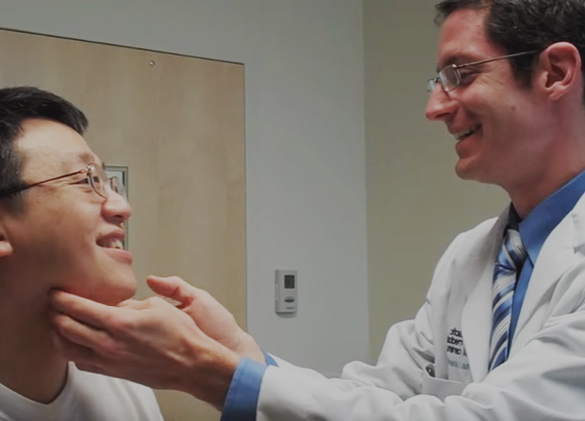In my last blog post I discussed male rhinoplasty surgery. Today we'll discuss what goes into fixing a crooked nose and review some before and after photos of a male rhinoplasty patient.
What makes it hard to straighten a deviated nose
One of the most difficult things to do during a rhinoplasty is to straighten a crooked nose. Several factors make this more challenging. The first factor is that the deviated cartilage and bone has a certain level of memory such that unless this is addressed the nose tends to drift back towards its pre-operative position. Another factor is that especially in congenitally crooked noses the nasal deviation may also occur in the setting of facial asymmetry. What this means is that it can be difficult to find a true midline plane in which to try to place the new nasal position.
Before and After Rhinoplasty Crooked Nose Rhinoplasty
The patient shown below is a great example of this concept of correcting a severely crooked nose.

The patient's severe nasal deviation to his right is obvious. This outward appearance is also reflected in his chronic nasal congestion and chronic mouth breathing. If we try to drop down a line showing the patient's midline one can see how the patient's tip is about a centimeter off midline. Did you notice that the patient's midline upper lip doesn't line up with the middline of his forehead teeth or chin? In cases like this I often find it best to place the new nasal position in line with the axis of the overall facial structure. Otherwise, a seemingly straight nose on an asymmetric face can look quite out of place.

How to straighten deviated nasal bones
Using an open septo-rhinoplasty approach I was able to reconstruct the patient's septum, relocating its starting point by the nostrils about a centimeter toward the left. To prevent the remainder of the nose from trying to veer back toward the patient's right I needed to detach much of the cartilagenous support from the surrounding bone and septum and then re-connect these components in their new, midline position. I also placed bilateral spreader grafts to help open up, straighten and support the narrow middle third of his nose.
The deviated nasal bones are made more straight by creating precisely controlled bone fractures under the skin using an osteotome (a fine-tipped, medical grade chisel). Once the bones are mobile they can be repositioned into a straighter position. After about 6 weeks the nasal bones are fully reset in their new position. Below you can see the before and 1 year postoperative results of this patient.

You can see that the patient's nose is much straighter in the 1 year postoperative photo. The patient's chronic nasal congestion was also greatly improved thanks to the more open nasal airway.
This patient also underwent a chin implant, hump reduction, and tip refinement. Check back soon where I'll discuss these aspects of his case further. [Check out how I made this patient's nose look smaller with a chin implant here.]
Want to find out if you're a candidate for rhinoplasty? Set up a virtual eConsultation or in-person appointment here.
Related Seattle Rhinoplasty Blog Posts:
- Before and after crooked nose rhinoplasty
- Computer morphing plastic surgery
- Deviated nasal septum and septoplasty information
- What a deviated septum looks like


